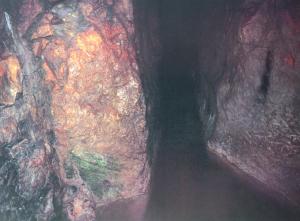Articles Showing 24 of 820

Jerusalem Geography
Hinnom Valley This valley formed the western boundary of the Upper City of Jesus' time; it began along the Western Hill and ended where the Tyropean and Kidron Valleys meet.Just west of Jerusalem, this valley was at one time the city sewage dump, ...

Jerusalem's Hinnom Valley
Jerusalem's Hinnom Valley marked the western and southern edges of Jerusalem, beginning along the Western Hill and ending where the Tyropean and Kidron Valleys meet. In the Old Testament, it was often the site where people of Judah sacrificed thei...

Jerusalem: Hezekiah's Water System
The main water supply for the city of Jerusalem was the spring of Gihon, which flowed out of a cave on the eastern side of the hill on which the city stood. The Hebrew word means "gushing out" and was given because the spring does not ha...

Jerusalem: Hezekiah's Water Tunnel
This tunnel was created by Hezekiah's workmen more than 700 years before Jesus. Working from the spring of Gihon on one side, and the western slope of the ridge of Jerusalem on the other, two teams of workmen created a tunnel by chiseling through ...

Jerusalem: The Cave of the Spring of Gihon
The water flowing out of this cave, the source of the spring of Gihon, is the reason Jerusalem was built on the ridge above.The spring provides more than 34,250 cubic feet of water per day. The water runs from the cave a short distance (about 33 f...

Jerusalem: The Eastern Gate
This gate was built in the sixteenth century, long after New Testament times. Several years ago, the Herodion remains were accidentally uncovered below this gate, indicating that it was probably built over the one used when Jesus visited the templ...

Jerusalem: The Midway Point in Hezekiah's Tunnel Where the Workers Met
The photograph shows the spot where the tunnelers met nearly at midpoint. The ability of these people to cut this small tunnel without modern instruments or tools is astonishing. The fact that they were only 10 feet off horizontally and none at al...

Jerusalem: The Southern Stairs
This photograph shows the southern stairs as viewed from the west, looking onto the stairs and Herod's massive Temple.On the right side of the photo is a straight joint in the wall. This is the beginning of Herod's extension of the Mount to the so...

Jerusalem: The Temple
This view is of the Temple, looking west. The Temple was one of the greatest buildings commissioned by Herod. The front was 170 feet high and 170 feet wide. The back portion was 170 feet high and 115 feet wide.The building was made of white marble...

Jerusalem: The Temple Mount Colonnade
The enormous Temple Mount of Herod had a 45-foot-wide colonnade around it. The eastern colonnade was called Solomon's Colonnade and was used by Jesus and the early Christians as a place of meeting and teaching. More than 40 feet high, the roof of ...

Jerusalem: Western Wall
This section of the Temple Mount Wall dates from the time of Herod. The Temple stood on the floor above the wall shown here. This particular wall would have been more than 40 feet above the street in Jesus day. The Roman destruction of the Temple ...

Jerusalem: Wilson's Arch
Located below the Old City of modern-day Jerusalem, Wilson's arch extended high above the street in Jesus' time. The arch supported a bridge across the Tyropean Valley from the Upper City on the Western Hill.Like Robinson's Arch (both of these we...

Jesus and the Jewish Revolts
Whereas some Jewish people sought salvation through political and military might, Jesus lived out completely different truths. He often warned his followers not to participate in a political method of bringing God's kingdom.Even though Jesus was c...

Jesus Definition
The promised Messiah, lived a remarkable life as a Jewish rabbi. Through his ministry, death, and resurrection, God fulfilled his covenant promises.

Jesus in the Synagogue
Jesus spent a lot of time in synagogues (Matt. 4:23). He taught in them (Matt. 13:54), healed in them (Luke 4:33'35; Mark 3:1-5), and debated the interpretation of Torah in them (John 6:28-59).His life seems to have followed Jewish education patte...

Jesus the Rabbi
The term rabbi in the time of Jesus did not necessarily refer to a specific office or occupation. That would be true only after the Temple in Jerusalem was destroyed (70 AD). Rather, it was a word meaning great one or my master which was applied t...

Jesus' Baptism
The Baptism of JesusOne of the greatest events to occur in relationship to the Jordan River was the baptism of Jesus. The gospel accounts tell us that a dove descended from heaven and hovered over the water as Jesus was baptized. A voice from heav...

Jesus' Genealogy
God's plan for the birth of the Savior unfolds through the people he chooses to be in Jesus' ancestral line.For example, Rahab, a prostitute in Jericho, hid two Israelite spies and believed in Yahweh. Because of this, she and her entire family wer...

Jesus' Power Over the Sea
During his ministry, Jesus demonstrated his authority over the sea and its destructive power. He walked on the stormy water (Mark 6:47-50; Matt. 14:22-33; John 6:16-20). And he calmed the storms on the sea (Mark 4:35-41; Matt. 8:23-27; Luke 8:22-2...

Jew Definition
At first, this was the name for someone from the tribe of Judah. Later it came to be used for anyone who was from the family of Jacob (Israel).

Jewish Feasts
Jewish Feasts In the Old Testament, God instituted a religious calendar for the Israelites to follow. Within each year, there were seven specified feasts (Lev. 23), four in the spring and three each fall. Through these feasts, the Jewish people ce...

Jewish Revolts
The Revolt Begins In AD 66, a Gentile in Caesarea offered a pagan sacrifice next to the synagogue's entrance on the Sabbath. Jewish citizens protested, so Jerusalem authorities ended all foreign sacrifices in the temple, including those to Caesar....

Jezreel Definition
City gaurding the Valley of Harod and the route from the Valley of Jezreel to Beth Shean. Here Ahab and Jezebel had a summer palace, Ahab stole Naboth's vineyard, and Jezebel was killed.

Jezreel Valley Definition
Means "valley of Megiddo." A fertile, agricultural valley whose strategic location led to frequent battles for control over the world trade route between the west and Mesopotamia. Used by biblical writers as the symbolic setting of the f...


